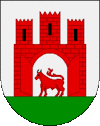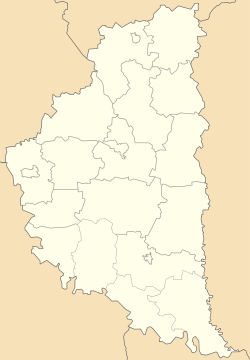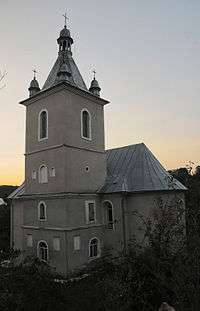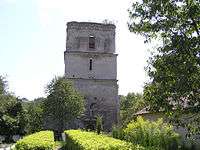Yazlovets
Yazlovets (Ukrainian: Язловець, romanized: Yazlovets; Polish: Jazłowiec; Russian: Яблуновка, romanized: Yablunovka; Yiddish: יאַזלאָוויץ, romanized: Yazlovits; Hebrew: יאזלובייץ, romanized: Yazlovits) is a village in the Buchach Raion, Ternopil Oblast, Ukraine and a Roman Catholic pilgrimage center of local significance. It's located at around 16 km south of Buchach and presently has around 600 inhabitants. In 1947–1991 it was known as Yablunivka.
Yazlovets Язловець | |
|---|---|
Village | |
Castle ruins and the monastery | |
 Coat of arms | |
 Yazlovets Location of Chortkiv in Ukraine | |
| Coordinates: 48°57′41″N 25°26′42″E | |
| Country | |
| Province | |
| District | Buchach Raion |
| First mentioned | 15th century |
| Time zone | UTC+2 (EET) |
| • Summer (DST) | UTC+3 (EEST) |
History


First written mention comes from the 15th century, naming Yazlovets, or Jazłowiec, as the town was called at that time, as the property of the Jazłowiecki noble family, a branch of the Buczacki family from neighboring Buchach (Buczacz). The heirs of Yazlovets are recorded in history for their contribution to the defense of Christendom against the Turkic invasion. Since 1340 until the Partitions of Poland (1772), Jazłowiec belonged to the Kingdom of Poland and the Polish-Lithuanian Commonwealth.
In the 16th century a stone church dedicated to the Assumption of the Blessed Virgin Mary, a monastery of the Dominican Order and a castle were constructed. In 1615 the Jazlowiecki family issued privileges encouraging Armenian refugees from the Crimea to settle in the town, similar to those found in Kamieniec Podolski, which brought in increased income from trade. The town's prosperity lasted until 1672, when it was captured by the Ottomans and occupied for ten years (see Polish–Ottoman War (1672–76)). It was nominally ruled by Ottomans between 1684-1699 and ravaged by Poles and Turks in this period. It was a sanjak centre as "Yazlofça" in Podolia Eyalet of Ottoman Empire. Jazlowiec returned to Poland after the Treaty of Karlowitz.
In the 18th century Jazlowiec was the property of successively Koniecpolski, Lubomirski and Poniatowski families. In 1718 the Pauline Fathers were invited to the town. In 1772 the town was detached from Poland, and came under Austrian rule, the policies of Emperor Joseph II led to the closing of both monasteries. In 1810 the ruined Armenian church was restored, given to the towns Ukrainian community and consecrated to St. Nicholaus.
In 1863 Marcelina Darowska established the monastery of the Sisters of the Immaculate Conception of the Blessed Virgin Mary in the ruined castle donated for this purpose. The sisters ministered in education first in Yazlovets itself and then creating a network of rural elementary schools. A Statue of Immaculately Conceived Mother of God was consecrated by saint archbishop Sigismund Felix Feliński in 1883 in the monastery's chapel and in 1939 crowned by the Cardinal Primate of Poland August Hlond with a crown given conferred by Pope Pius XII.
During World War I Yazlovets was heavily damaged by Russians in 1916.
After the formation in November 1918 West Ukrainian People's Republic (ZUNR) Yazlovets came of it.
On July 11–13, 1919 a three-day-long battle was fought over the city by Poles and Ukrainians locked in a fratricidal conflict, each trying to secure their statehood. The battle against unit of Ukrainian Galician Army was won by Poles; and until the Invasion of Poland, Jazlowiec belonged to Tarnopol Voivodeship, Second Polish Republic. To commemorate Polish victory in the 1919 battle, 14th Uhlan Regiment of the Polish Army, stationed in the interwar period in Lwow (Lviv), was called the 14th Regiment of Jazlowiec Uhlans. Following the 1939 Soviet Invasion of Poland, the region fell under Soviet rule with the outbreak of World War II.
In 1945 the town was degraded to the status of a village and renamed to Yablunivka, or Yablonovka in Russian, and most of its Polish residents were resettled in the so-called Recovered Territories. The monastery was closed by communists in 1946. However following the collapse of the soviet union and the reemergence of independent Ukraine after half a century the original name was restored and the monastery was renewed. For safety the Statue was moved in 1946 to Szymanów, near Niepokalanów about 20 km from the Polish capital of Warsaw, where it still remains, but a copy has been placed in Yazlovets. After the beatification of Marcelina Darowska by the Pope John Paul II in 1996, the chapel of the Sisters in Yazlovets was proclaimed a Sanctuary of the Blessed Marcelina Darowska on September 1, 1999 by the Latin Rite Metropolitan of Lviv Cardinal Marian Jaworski.
Attractions
- Yazlovets castle
- Church of St. Nicholas, UGCC
- Roman Catholic church, n. 1590, ruins
Notable people from Yazlovets
- Blessed Marcelina Darowska
- Jerzy Jazłowiecki, Polish hetman
- Mikołaj Gomółka, Polish composer
- Osyp Nazaruk, Ukrainian writer and politician
- Kornel Ujejski, Polish romantic poet
- Karol D. Witkowski, Polish-American painter, also known as Karl Witkowski (1860-1910)
External links
| Wikimedia Commons has media related to Yazlovets. |